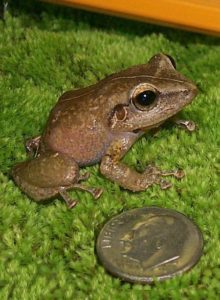 Anyone who has spent any time on the Big Island in recent years has certainly heard the cacophonous call of the coqui frog. An invasive species from Puerto Rico, the coqui frog first became established on Hawaii Island back in the mid 1990s. The District of Puna fast became ground zero for frog proliferation, and through the years, vast colonies of coqui frogs have spread all over the island.
Anyone who has spent any time on the Big Island in recent years has certainly heard the cacophonous call of the coqui frog. An invasive species from Puerto Rico, the coqui frog first became established on Hawaii Island back in the mid 1990s. The District of Puna fast became ground zero for frog proliferation, and through the years, vast colonies of coqui frogs have spread all over the island.
It’s not just the noise that makes coqui frogs a problem. A recent academic study by the world’s foremost coqui expert reveals that coqui populations adversely affect the delicate ecosystem of beneficial insects while contributing to a 19 percent increase in mosquito populations. Unfortunately and conversely, bee populations can decline by 19 percent in coqui-infested areas.
Female frogs are nomadic; male frogs are territorial and generally stay in one place. It takes 8 months for a male froglet to grow up into an adult caller. A single female frog can produce clutches of 20 to 75 eggs per clutch every two weeks, and a total of 1,500 offspring a year. In wild spaces on the Big Island, there can be 15,000 to 16,000 frogs per acre! Adult frogs can live between four to six years.
If you are selling your home and you have frogs on your property, you must disclose that fact to the potential buyer. Coqui frogs can affect the appraisal price of your property. Some resort communities in Kona have now implemented a strict no-coqui frog policy (up to $1o,000 coqui frog deposit) directed toward people who a building a new home and might be inadvertently importing potentially infested lumber and landscaping into the subdivision.
Citric acid is the only county-approved chemical that can be utilized for coqui frog control (commercially). Although not officially sanctioned, baking soda also works just as well as citric acid for killing frogs. You can use baking soda on your own property. Hydrated lime is another substance that has been used to control coqui frogs. Any of these substances require direct contact with the frog, which will usually die within a few minutes. Since citric acid is a food-grade substance, it is listed a non-restricted chemical. Although it is safe for most plants, it can burn sensitive plants like orchids and ferns. Citric acid needs to be mixed with water and sprayed onto infested areas. Thoroughly spray to cover the vegetation where frogs are perched including the undersides of leaves, and the areas of leaf litter on the ground. To salvage sensitive plants, rinse thoroughly with water approximately one hour after spraying.
Hot water approximately 113 degrees will kill frogs on nursery plants. Potted plants can be placed in a bathtub and showered with hot water, followed by one minute of cole water to cool off the plant. This treatment will kill any frogs or eggs in the plant. Outside in your yard, eliminated frog-friendly habitats. During the day, coqui frogs retreat under left litter of other moist shelter including piles of building material or empty pots. At night, they emerge to fee. Themeless climb and perch on vegetation to call. Dispose of green waste by treating with hot water, citric acid or hydrated lime to kill any frogs or eggs.